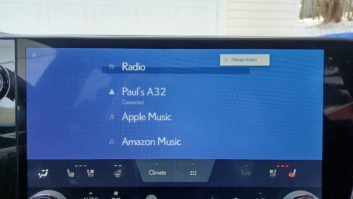Broadcast engineering veteran Lincoln Hubbard tells us of the value of a car wash should you ever have to clean up in the wake of a flood.
After one of his station’s transmitter sites underwent the Noah thing, he took his gear down to a do-it-yourself facility to remove the mud and gunk left over. Although I’ve heard of this technique, I’ve never spoken to an engineer who used it.
He took the transmitter to the car wash bay and cleaned it thoroughly with a hand-held nozzle. He removed all of the mud and tilted the transmitter to remove standing water. He let it dry for several days before re-installing.
Lincoln also cleaned the telco line equalizer, the Burk remote control, two AC line surge protectors and two chassis’ worth of relays that interfaced the remote control with pattern change controller. All had been under the floodwaters; all were cleaned at the car wash, allowed to dry thoroughly and restored to service.
Lincoln also salvaged two vacuum cleaners and a floor fan that were thrown out. Everything worked after cleaning. His only added procedure was to coat the dried relay coils and motor coils with polyurethane sealer.
Lincoln has also cleaned TVs this way … even car radios that had been under salt water. Of course, the important step is thorough drying before you apply power.
Lincoln sums the technique up by saying the engineering part was no more than washing a pair of BVDs!
* * *
Pricing three-phase power installation for a remote or mountaintop transmitter site used to mean investing in less costly motorized rotary phase converters.
These devices solved the single-phase problem by generating three-phase power; but they required maintenance. Sometimes stability was a problem, as were over- and under-voltage conditions.
Contract Engineer Jon Bennett in Richmond, Va., reports great results with a recently installed Phase Perfect solid-state phase converter.
The folks at Phase Technologies offer a patented solution. Their system has no moving parts except for time delay contactors. See Fig. 1.
(click thumbnail)
Fig. 1: A solid-state phase converter means extremely stable three-phase power.


Fig. 2: The Phase Perfect converter, mounted and ready for service.
The result is extremely stable three-phase power, with a power factor correction to near unity (0.99) under all load conditions. The efficiency is 97 percent, and the system protects equipment from over-voltage, under-voltage and single-phasing conditions. Jon says Harris is selling these for use with higher-power, three-phase transmitters at stations with only single-phase power sources.
You can find out more by heading to Phase Technologies’ website. Want to find out more about phase converters? Download their paper, “A Comparison of Phase Converter Technologies,” from their site.
* * *
Ron Nott of Nott Ltd. noted our several recent mentions in Workbench about installing ground rods.
Back in 1972, Ron was building a new TV station. After the tower was erected, it was time to install the grounding for it. A person on the scene suggested that he try his method; all that is needed was a shovel, a bucket of water and the ground rod. No hammers, post pounders or drills.
At the rod location, the contractor dug a small hole about a foot in diameter and 6 inches deep. The hole was filled with water and then the rod was placed in the middle of the hole. The contractor simply jigged the rod up and down gently, and it slowly sank into the soil.
After a bit, the water disappeared, so the contractor added more water to the hole. He continued jigging the rod up and down a few inches at a time, until the 8-foot, 5/8-inch-diameter rod was all the way in the ground. It was amazing.
Obviously this technique won’t work in rocky soil; but in normal alluvial soil it worked great. Ron put in two more rods by the same method, then connected them to the tower base with heavy wire. The time needed to install each rod was only about 10 minutes.
This technique is similar to the one described by Steve Heaton in the Oct. 20 issue. The only difference is the diameter of the hole. A larger hole, filled with water, more easily saturates the soil, making it easier to “drive” the rod.
Speaking of grounding, if you are considering lightning mitigation or AM tuning and detuning devices, visit Ron’s website.
John Bisset marked his 40th year in radio in broadcasting recently. He works for Tieline Technology and is a past recipient of the SBE’s Educator of the Year Award. Reach him at [email protected] or (603) 472-5282. Faxed submissions can be sent to (603) 472-4944.
Submissions for this column are encouraged and qualify for SBE recertification credit.












